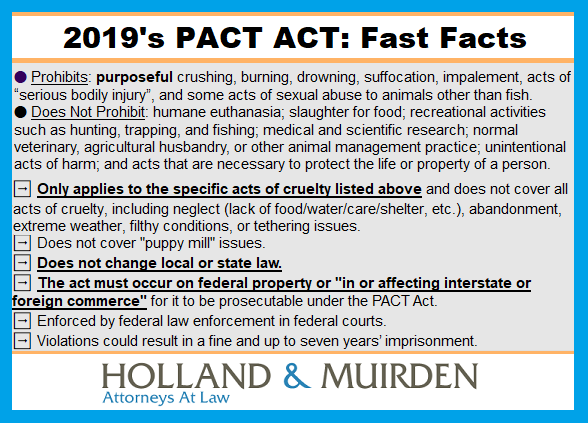The PACT Act (Preventing Animal Cruelty and Torture Act) was signed into federal law yesterday! This is a great law that builds on 2010’s Animal Crush Prohibition Act by making any activity defined as “animal crushing” potentially a federal crime, whether or not the act is committed as part of a crush video.
Unfortunately, there are lots of misleading and confusing headlines on this law, including that the PACT Act:
“makes animal cruelty a federal felony”
“Mak[es] Cruelty To Animals A Federal Crime”
“Bans Cruelty”
“Make[s] Animal Abuse a Federal Offense”
is a “Sweeping Federal Ban on Animal Cruelty”
covers “Most animal cruelty”
The PACT Act does make some animal cruelty a federal offense, but it isn’t that simple! Here are the basics:
✏️ What is “Animal Crushing”?
➡️ Animal crushing commonly refers to extreme fetish videos depicting animal abuse—where small animals are crushed, ripped apart, burned, or otherwise tortured to death. Usually, this is designed for the sexual gratification of the viewer. In 2010, a federal law was passed that banned the creation or depiction of such videos/acts, but NOT the actual underlying act of animal cruelty.
✏️ What does the PACT Act cover?
➡️ It outlaws purposeful crushing, burning, drowning, suffocation, impalement and other purposeful acts that cause “serious bodily injury” to animals other than fish. It also prohibits some acts of sexual abuse against animals other than fish, but this particular provision seems to have a qualifier that such acts are only prohibited if committed in the “special maritime and territorial jurisdiction of the United States” (federal property). The rest of the PACT Act applies to acts “in or affecting interstate or foreign commerce,” in addition to federal property. This limitation on the jurisdiction of animal sexual abuse crimes seems to negatively affect the federal prosecution of, for example, bestiality videos that are distributed online.
➡️ It outlines exemptions for humane euthanasia; slaughter for food; recreational activities such as hunting, trapping, and fishing; medical and scientific research; normal veterinary, agricultural husbandry, or other animal management practice; unintentional acts; and acts that are necessary to protect the life or property of a person.
➡️ It does not apply to anything other than the specific acts of cruelty listed above.
➡️ It does not cover all acts of animal cruelty.
➡️ It does not cover acts of neglect, abandonment, extreme weather, filthy conditions, or tethering issues.
➡️ It does not cover “puppy mill” issues.
✏️ Does the PACT Act change state and local law?
➡️ No. An offender can only be prosecuted pursuant to the PACT Act if the criminal act occurs on federal property (ex: national parks, military bases) or “in or affecting interstate or foreign commerce.” Federal property (“special maritime and territorial jurisdiction of the United States”) is defined in 8 subsections of 18 U.S.C. § 7: maritime jurisdiction, 18 U.S.C. §§ 7(1), 7(2); lands and buildings, 18 U.S.C. § 7(3); Guano Islands, 18 U.S.C. §7(4); aircraft, 18 U.S.C. § 7(5); spacecraft, 18 U.S.C. § 7(6); places outside the jurisdiction of any nation, 18 U.S.C. § 7(7); and foreign vessels en route to and from the United States, 18 U.S.C. § 7(8)).
➡️ The PACT Act was designed not to preempt or interfere with local/state animal cruelty laws or enforcement. The PACT Act is merely a federal overlay, exactly like the federal animal fighting law(s).
✏️ Who enforces the PACT Act?
➡️ Federal law enforcement in federal courts.
✏️ What are the possible punishments for violation of the PACT Act?
➡️ Violations could result in a fine and up to seven years’ imprisonment.
✏️ Does the PACT Act make all animal cruelty a felony?
➡️ No. As noted above, the PACT Act only applies in a narrow set of circumstances. State and local legislation to strengthen animal cruelty and neglect laws are still needed and very much necessary.

